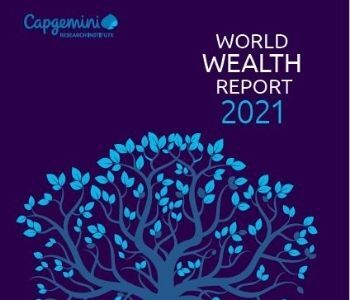What is this Report?

The World Wealth Report is an annual report about the wealth of high-net-worth individuals (HNWIs) and the economic conditions in the Wealth Management industry. This year’s report is based on responses from over 2,900 HNWIs in 26 wealth markets, administered between February and March 2021.
Capgemini defines HNWI as those who have “investable assets of US $1 million or more, excluding primary residence, collectibles, consumables, and consumer durables.”
What are the key findings from the article?
- Wealth increased despite the disruption of the coronavirus, with a rise in global High Net Worth Individuals (HNWI) of 6.3% and financial wealth of 7.6%.
- “72% of HNWIs have invested in cryptocurrencies and 74% have invested in other digital assets (e.g., website domain names). ”Fidelity is reportedly launching a bit-coin exchanged traded fund as well as Robo-advisor Wealthfront announced the availability of crypto investment options for its investors.
- Demographics are changing. Women own 40% of US Businesses with 114% more women entrepreneurs than 20 years ago, the report says. Family structures are also changing. 41% of HNWIs from LGBTQ+ thought their needs were being met.
- In 2020, North America passed Asia-Pacific for both wealth and population of HNWI. The report credits the big change due to rising equity markets and government stimulus. North America saw growth of 10.7% in HNWI population and 11.9% in wealth.Capgemini speculates the increase in wealth is from equity as well as tech stocks rising dramatically since 2019.
- 62.9% of global HNWI population is in United States, Japan, Germany and China. Brazil’s ranking dropped three spots to 22.
- Financial markets are not tied to the real economy anymore. The market bounced around, but kept rising, while the economy on Main Street faltered as people left the workforce, hunger rose, etc. Capgemini ascribes the decoupling as a result of Tech stock dominance, and liquidity from retail investors due to digital investing platforms. “Earlier this year, a Deutsche Bank survey found Americans aged 25-34 planning to invest 50% of their stimulus checks on stocks–a potential US equity market infusion of USD170 billion.”
- HNWI want to play a more hands-on approach with their investments. Looking back at 25 years, Capgemini notes that HNWIs were interested in philanthropic investments and socially responsible investing. The 2008 crisis saw a decline in this area but after the crisis faded, interest increased. Capgemini also found that HNWIs tend to be self-sufficient in making financial decisions during good economic periods, but want advice during market crises. “43% of Ultra HNWIs and 39% of HNWIs age 40 or younger are likely to request an environmental, social, governance score for products offered by their firm.”
- There are over 7,300 family offices with estimated $5.9 trillion in assets. Family Offices are companies that manage the wealth of a single individual or a family. These offices can also help with succession planning, philanthropy, trusts and estate planning. North American has the majority of them at 42%, followed by Europeat 32%.
What can I do as a result?
- Wealth was created in the US despite the economic downturn and coronavirus. Don’t assume people are hesitant to give big. There are still opportunities to reach out to new and known prospects to raise funds for your organization.
- More wealth may be held in equity than cash so be prepared to get creative when asking major gifts. Being receptive to securities and other holdings might bea way to get big gifts through the door. If your gift officers don’t have experience with assets, consider partnering with a financial advisor to offer educational experiences for your donor prospects to learn about gifting assets.
- Cryptocurrencies are here. The debate about whether cryptocurrencies are a fad is less relevant. People are investing in them so charities need to start thinking about whether they should accept them and if so, how they should do so.
- Don’t forget the women. 40% of US businesses are run by women, so that’s a lot of potential from women prospects as well as their companies. As we know, fundraising, especially major giving, isn’t really one size fits all. Figure out how to attract and cultivate your female donors. And given shifting family dynamics, figure out how you can cultivate LGBTQ+ prospects, too.
- Family offices are a significant wealth indicator. The vast majority of family offices are located in North America. It’s suggestive that the family not only has the money to afford a private office to manage their wealth (and other related activities), they have the wealth that needs to be managed.
Additional Resources
- World Wealth Report l Capgemini 2021
- The Cryptocurrency Merry-Go-Round: Are you on? l Aspire Research Group 2021
- Women’s Hack Guide To Prospect Research l Jen Filla Blog 2018
- Not Asking for Millions? Why Should You Care About HNWIs? l Jennifer Filla blog 2018
- Please Don’t Donate Cash l PG Calc 2018
- Cash is Not King in Fundraising Executive Summary l PG Calc 2018